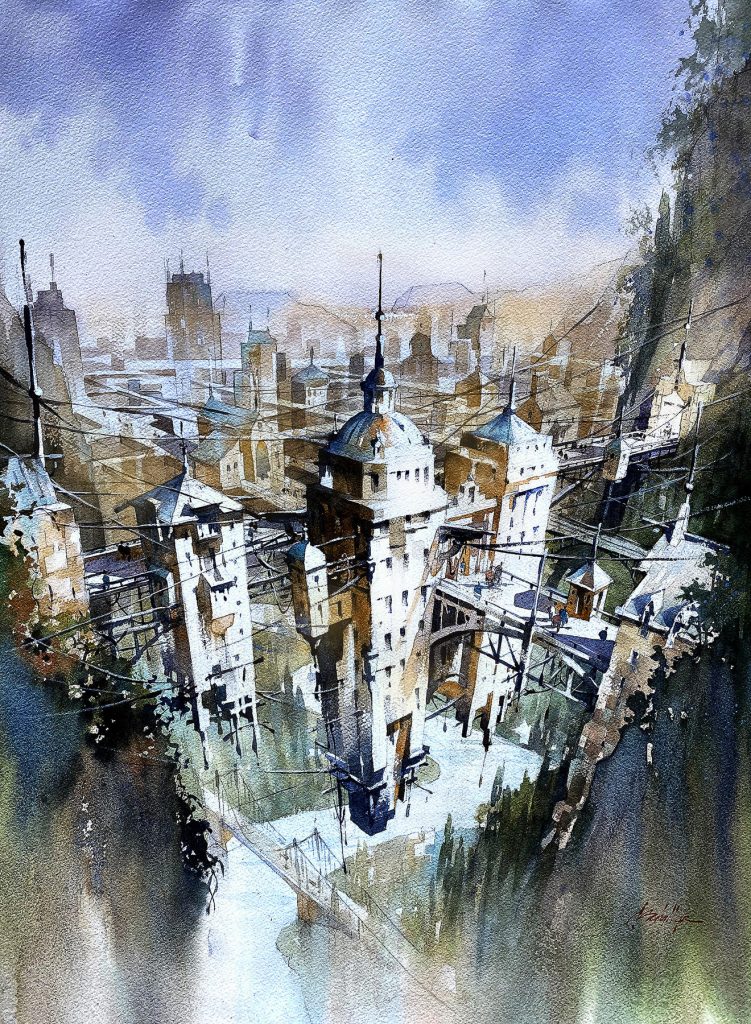I had read Italo Calvino’s remarkable book Invisible Cities many years before I had seen the equally remarkable work of Thomas Schaller. Invisible Cities is a sparkling work of fiction in which an imagined Marco Polo recounts to Kubla Khan descriptions of cities he has visited. The accounts are of places that do not exist except in the imagination, and it took a wonderful act of imagination for Calvino to invent them. When I first saw the evocative and often magical cityscapes rendered in watercolor by Thomas Schaller, I immediately felt a connection with Calvino. I don’t know what inspired me to do it, but yesterday I composed an email to Schaller asking him if he knew the book, and suggesting that an edition of it illustrated by him would be a fantastic undertaking. I had even gone to the trouble of finding the literary agent in Italy who handles the work of the now-deceased Calvino. And so out into the ether went the email.
Less than two hours later, I got a reply. Thomas Schaller said “Oh yes. I re-read Invisible Cities almost every year. Calvino was a huge influence on me as a student and continues to be to this day. Much of what I have done in the art field is directly linked to the inspiration I received from him. Just a few weeks ago, I won an international drawing competition [sponsored by Architize Architecture] with one of my works inspired by his writing.” And he sent me a photo of the painting “Octavia” and a link to an interview done with him by Architizer’s Architecture Editor, Hannah Feniak (see below).

As Schaller notes in the interview, ” One of the cities visited is Octavia, described in the book as suspended high above the Earth between two rocky mountain peaks by a tenuous spider’s web of cables and wires. Countless metaphors and analogies can be drawn. One of course is the dependence of any city on a healthy infrastructure of roads, bridges and lines of communication, etc. But another more broad theme is the “infrastructure” of humanity itself. Our very real need to congregate, to form groups for safety, sanity and survival was, for me, the takeaway and the theme of my drawing.”
Schaller goes on to say ” Repeat readings of Invisible Cities helped me to form the cornerstone of what would become my ‘artistic voice’. I am more aware of contrasts than anything else as I move through the world. By that I mean of course the clash of dark and light, but also ideas about what is real or simply imagined, the man-made and the natural environments, warm and cool tonalities, vertical, horizontal, and diagonal energies, and thoughts about time — what is past, present, or yet to be. As polarities meet and find some kind of resolution — or not — this is what my work is always about, trying to find a resolution on paper of two or more things in opposition.”
Finally, he adds a specific note about working in watercolor. “I think of watercolor as a ‘subtractive’ process in that we begin with a piece of white paper, 100% in light. And we proceed to subtract away some of this light as we go. The transparent nature of watercolor enhances our potential to study light. And in the end, the parts of our work that are not painted can be as powerful and full of meaning as those which are painted.”
This view into the mind and process of an artist I very much admire resulted from a spontaneous outreach by email. It validated my instinct that Calvino and Schaller are very much in sync, and renews my conviction that in some way, all art forms – written, visual, tactile, utilitarian – are related and benefit from interaction with each other. I am profoundly grateful for Thomas Schaller’s gracious and welcoming exchange of emails.
I would still love to see an edition of Invisible Cities illustrated by Schaller…
This little piece is written with his consent and approval.
If you would like to read the entire interview, you can find it here:
One Drawing Challenge Winner Explores Enduring Truths at the Heart of a Classic Book Beloved by Architects Worldwide
Carla Scheidlinger